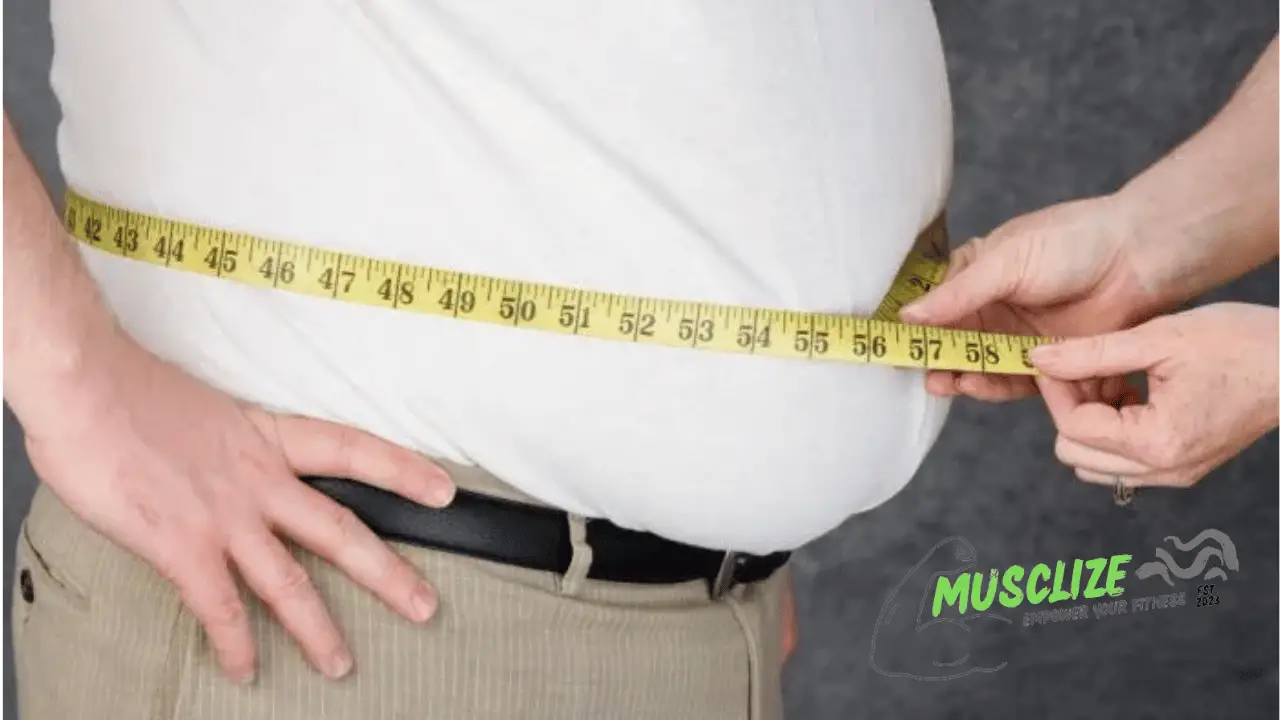The battle against belly fat is a common struggle for men seeking to improve their health and appearance. Excess abdominal fat not only affects self-confidence but also poses serious health risks.
Men with a larger waist circumference are more likely to experience complications like heart disease, type 2 diabetes, and certain cancers. Therefore, understanding the significance of reducing belly fat is essential for men’s overall well-being.
The importance of reducing belly fat for men’s health
Reducing belly fat is crucial for men due to the health risks of excess abdominal adiposity. Unlike subcutaneous fat (found just beneath the skin), visceral fat accumulates deep within the abdominal cavity, surrounding vital organs such as the liver and intestines.
This type of fat releases inflammatory substances called cytokines that can lead to chronic inflammation, insulin resistance, and metabolic disorders. Moreover, excessive visceral fat disrupts hormonal balance by increasing cortisol levels, a stress hormone associated with weight gain and muscle breakdown.
This hormonal imbalance also decreases testosterone production, reducing muscle mass, diminished libido, and causing mood swings. By targeting belly fat through exercise, men can mitigate these health risks while improving their overall quality of life.
Overview of the benefits of exercise in targeting belly fat
Exercise is an indispensable weapon for fighting stubborn belly fat. Not only does it help shed excess pounds from all over the body, but it targets explicitly visceral fatty tissue around the midsection. Regular physical activity stimulates various physiological processes that contribute to reducing abdominal obesity.
Firstly, exercise promotes weight loss by increasing calorie expenditure through physical exertion. Whether it’s high-intensity interval training (HIIT) or steady-state cardio exercises like running or cycling, these activities elevate heart rate and metabolism during and after workouts, leading to energy expenditure even at rest.
Secondly, specific mechanisms come into play when targeting belly fat. Regular exercise stimulates the release of hormones like growth hormone (GH) and catecholamines, which promote fat oxidation and reduce visceral fat accumulation.
Additionally, exercise increases insulin sensitivity, allowing for more efficient blood glucose regulation and reduced insulin resistance. Men should recognize that reducing belly fat goes beyond mere aesthetics.
It is essential for maintaining optimal health and well-being. By implementing regular exercise routines, men can achieve a flatter midsection and reduce their risk of developing severe health conditions while enjoying enhanced self-confidence and vitality.
Understanding Belly Fat

Differentiating between Subcutaneous and Visceral Fat
Regarding belly fat, it is essential to understand the distinction between subcutaneous and visceral fat. Subcutaneous fat lies directly beneath the skin and is usually responsible for the “love handles,” or the cushiony layer we can pinch around our midsection.
On the other hand, visceral fat resides deeper within the abdominal cavity, surrounding vital organs such as the liver, pancreas, and intestines. Unlike subcutaneous fat, which is relatively harmless from a health perspective, excess visceral fat poses a significant risk to overall well-being.
Explaining the Health Risks Associated with Excess Visceral Fat
Excess visceral fat goes beyond mere cosmetic concerns; it carries serious health risks. Research has consistently shown that individuals with higher levels of visceral fat are more prone to developing various chronic diseases such as heart disease, type 2 diabetes, hypertension, and even certain types of cancer.
This correlation arises due to visceral fat’s metabolically active nature—it releases hormones and inflammatory substances that disrupt normal bodily functions. These disruptions can lead to insulin resistance, elevated blood pressure levels, imbalanced cholesterol profiles, and systemic inflammation.
Moreover, excess visceral fat has been explicitly linked to an increased risk of cardiovascular disease. The proximity of this deep abdominal adipose tissue to vital organs exposes them to higher levels of harmful fatty acids released by visceral fat cells.
This influx of free fatty acids contributes to insulin resistance and inflammation in blood vessels and promotes plaque formation inside arteries, a condition known as atherosclerosis. Over time, these arterial plaques can lead to restricted blood flow or even cause blockages that trigger major cardiovascular events like heart attacks or strokes.
Furthermore, excess visceral fat sometimes impacts lung function by compressing the diaphragm muscle. This compression reduces the lung’s ability to expand fully, limiting oxygen intake and impairing overall respiratory efficiency.
This compromised lung function affects physical performance and increases the risk of developing respiratory disorders such as asthma or chronic obstructive pulmonary disease (COPD). Comprehending the differences between subcutaneous and visceral fat is crucial in understanding the health consequences associated with excess belly fat.
While subcutaneous fat may be frustrating from an aesthetic standpoint, visceral fat poses a significant threat to overall well-being. The release of inflammatory substances and hormones from visceral fat cells disrupts normal bodily functions, increasing the risk of chronic diseases such as heart disease, type 2 diabetes, hypertension, and certain cancers.
Excess visceral fat also contributes to arterial plaque formation, compromising cardiovascular health and even impacting lung function. Therefore, adopting strategies to reduce visceral fat through exercise becomes essential for mitigating these health risks and improving overall quality of life.
The Science Behind Belly Fat Reduction

How exercise promotes overall weight loss and calorie burn
When it comes to shedding excess belly fat, exercise is an indispensable tool. Regular physical activity not only helps in reducing overall body weight but also aids in burning calories. Engaging in exercises that elevate the heart rate, such as cardiovascular workouts, stimulates the body to utilize stored energy reserves, including visceral fat around the abdomen.
Exercise triggers physiological responses that contribute to weight loss and calorie burn. The body’s metabolism increases during physical exertion, leading to higher energy expenditure.
This metabolic boost extends beyond workout sessions, as regular exercise elevates basal metabolic rate (BMR), meaning more calories are burned even at rest. Additionally, engaging in intense cardiovascular activities like high-intensity interval training (HIIT) provides an “afterburn effect” or excess post-exercise oxygen consumption (EPOC), where the body continues to consume oxygen at a higher rate post-workout to restore energy levels and repair tissues.
Specific mechanisms by which exercise targets belly fat
While exercise aids in weight loss and calorie burn, specific mechanisms specifically target belly fat reduction. One of these mechanisms is increased insulin sensitivity.
Physical activity improves insulin sensitivity by enhancing glucose uptake into muscles for energy production rather than storing it as fat. This reduced insulin resistance helps prevent excess abdominal fat accumulation.
Another significant mechanism is the activation of lipolysis, the breakdown of stored fats for energy use. Exercise stimulates lipolytic enzymes that effectively break down triglycerides stored within adipose tissue, including stubborn belly fat stores.
As a result, these fatty acids are released into circulation and utilized during physical activity. Moreover, exercise is crucial in reducing stress levels by releasing endorphins, – natural mood-enhancing chemicals in the brain.
By mitigating stress-induced cortisol production, exercise helps prevent additional belly fat deposition. High cortisol levels have been associated with increased visceral fat accumulation due to its role in promoting hunger, overeating, and fat storage around the abdominal region.
Engaging in resistance training exercises to build muscle mass contributes to belly fat reduction. Increased muscle mass boosts metabolism and promotes a higher calorie burn even at rest.
As muscles require more energy to sustain themselves than fat tissue, incorporating strength training into exercise routines can significantly reduce belly fat over time. Exercise is a powerful tool for reducing belly fat because it promotes overall weight loss and calorie burn.
Through various mechanisms such as increased insulin sensitivity, lipolysis activation, stress reduction, and muscle building, physical activity specifically targets stubborn visceral fat stored around the abdomen. By incorporating regular exercise routines that combine cardiovascular workouts with strength training exercises, individuals can embark on a journey toward achieving a toned midsection and improved health.
Types of Exercises to Reduce Belly Fat

Cardiovascular exercises for overall weight loss
Subtitle: Sweating off the Excess Pounds When shedding excess belly fat, cardiovascular exercises are crucial to any workout routine.
These exercises elevate your heart rate, allowing you to burn calories effectively and promote weight loss. Among the most effective options is high-intensity interval training (HIIT), a workout technique that alternates between intense bursts of activity and short recovery periods.
HIIT has shown remarkable results in reducing belly fat due to its ability to stimulate metabolism long after the workout. Another great option for cardiovascular exercise is engaging in activities such as running, cycling, swimming, or brisk walking.
These endurance-based exercises engage large muscle groups and raise your heart rate, accelerating calorie burn. They can be easily incorporated into your daily routine, whether through a morning jog or biking to work.
Strength training exercises to build muscle mass and increase metabolism
Subtitle: Sculpting Your Way to a Toned Physique While cardio workouts are essential in reducing overall body fat, strength training must be considered when targeting belly fat specifically.
Building muscle mass through resistance training increases your metabolic rate, improves insulin sensitivity, and promotes healthy hormone balance. Compound exercises like squats, deadlifts, and bench presses effectively engage multiple muscle groups simultaneously.
They require core stability while working significant muscles such as glutes, quads, hamstrings, chest, back, and shoulders. These compound movements stimulate significant muscle growth while boosting metabolism during exercise and rest.
Consider incorporating resistance bands or weights into your routine to further intensify strength training workouts and accelerate belly fat reduction efforts. These tools add extra resistance that challenges muscles even more as they contract, increasing muscular strength and fat burning.
Core-strengthening exercises to tone abdominal muscles
Subtitle: Carving Out a Sculpted Midsection To achieve a toned and defined midsection, core-strengthening exercises are vital. These exercises specifically target the abdominal muscles, helping to tone and tighten them.
Exercises such as planks, crunches, Russian twists, and leg raises are excellent for engaging the core muscles effectively. Planks, for example, engage not only the rectus abdominis but also the deep stabilizing muscles of the core.
Crunches work the upper abs by flexing the spine, while Russian twists engage the obliques by rotating the torso. Pilates or yoga routines can be highly beneficial for those seeking a more holistic approach that not only strengthens but also increases flexibility and overall body awareness.
These practices involve flowing movements that engage and stabilize core muscles throughout various poses or exercises. They provide an excellent opportunity to enhance the mind-body connection while sculpting your midsection.
By incorporating cardiovascular workouts for overall weight loss, strength training exercises to build muscle mass, and core-strengthening exercises for abdominal toning into your fitness routine, you can effectively target belly fat while improving overall fitness levels. Before starting any new exercise regimen, remember to consult with a qualified fitness professional to ensure proper form and technique while minimizing injury risk.
Tailoring Exercise Routine for Individual Needs
Caloric intake considerations based on basal metabolic rate (BMR)
To effectively reduce belly fat, it is crucial to address not only exercise but also the role of nutrition. Caloric intake plays a significant role in determining the success of any weight loss endeavor, including reducing belly fat. Understanding your basal metabolic rate (BMR) is essential to tailoring your exercise routine to meet your needs.
BMR refers to the number of calories your body requires to maintain essential bodily functions at rest. Age, gender, weight, and height influence your BMR.
Calculating your BMR gives you insight into the minimum number of daily calories needed to sustain these functions. To reduce belly fat, it is generally recommended to create a caloric deficit by consuming slightly fewer calories than your BMR.
Consulting a fitness professional to design a personalized workout plan
While general exercise guidelines can be helpful, every individual has unique requirements and goals for reducing belly fat. Consulting a fitness professional can guide you in designing a personalized workout plan that caters to your needs.
When creating an exercise routine tailored for you, a fitness professional will consider factors such as your current fitness level, any existing health conditions or injuries, and personal preferences. They will ensure that the chosen exercises target belly fat effectively while considering any limitations or specific requirements you may have.
Adjusting intensity and duration as fitness levels improve
As you progress on your journey towards reducing belly fat, it is crucial to continually challenge yourself and adapt your exercise routine accordingly. Increasing the intensity and duration of workouts helps stimulate further calorie burn and promotes ongoing abdominal fat reduction.
By gradually increasing the intensity of cardiovascular exercises such as HIIT or incorporating more challenging strength training routines, you can push your body to new limits. This not only aids in shedding belly fat but also helps build muscle and enhance overall fitness levels.
Monitoring your progress and periodically adjusting the intensity and duration of your workouts ensures continuous improvement and prevents plateauing. Tailoring an exercise routine to meet individual needs is imperative for effectively reducing belly fat.
Considering caloric intake based on BMR provides a foundation for controlling weight, while consulting with a fitness professional assists in designing a personalized workout plan that suits your specific requirements. Adjust intensity and duration as fitness levels improve to continue challenging yourself and achieve consistent progress in reducing belly fat.
Nutrition Tips to Complement Exercise
Eating a balanced diet rich in lean proteins, whole grains, fruits, and vegetables
To effectively reduce belly fat, adopting a balanced diet that provides the necessary nutrients for fueling your body and aiding in fat loss is paramount. Incorporating lean proteins like chicken breast, fish, tofu, or legumes into your meals helps promote muscle growth and repair while keeping you satiated for extended periods.
Additionally, whole grains such as quinoa, brown rice, and oatmeal provide complex carbohydrates that deliver sustained energy throughout the day. Optimal intake of fruits and vegetables offers vital vitamins, minerals, and fiber that aid digestion and support overall health.
Avoiding processed foods high in trans fats and sugars
When aiming for a trimmer waistline, it is crucial to steer clear of processed foods laden with trans fats and excessive amounts of added sugars. These harmful components contribute to weight gain and increase the risk of developing chronic health conditions such as heart disease and diabetes. Instead of indulging in sugary drinks or snacks with empty calories, opt for healthier alternatives like water infused with fresh fruit or homemade smoothies sweetened with natural ingredients like honey or dates.
Incorporating foods that promote a healthy gut
A healthy gut plays a significant role in maintaining overall well-being. Including probiotic-rich foods like yogurt or kefir can enhance the balance of good bacteria in your digestive system while promoting efficient nutrient absorption. Additionally, incorporating fiber-rich foods such as legumes, leafy greens, berries, and whole grains helps maintain regular bowel movements and supports gut health.
Conclusion
By combining regular exercise routines tailored to target belly fat with a nutritionally balanced diet,
Men can significantly reduce their waist circumference. Remember, consistency is critical, and gradual progress should be celebrated!
With dedication and determination, a healthier body composition and enhanced well-being are within reach. Adopting a positive mindset is essential throughout this journey.
as small changes in lifestyle can ultimately yield remarkable results. Embrace the process and enjoy the transformation both internally and externally.

